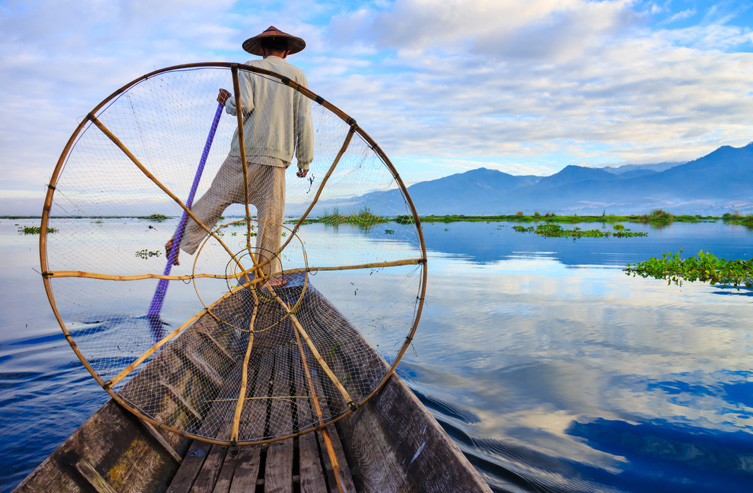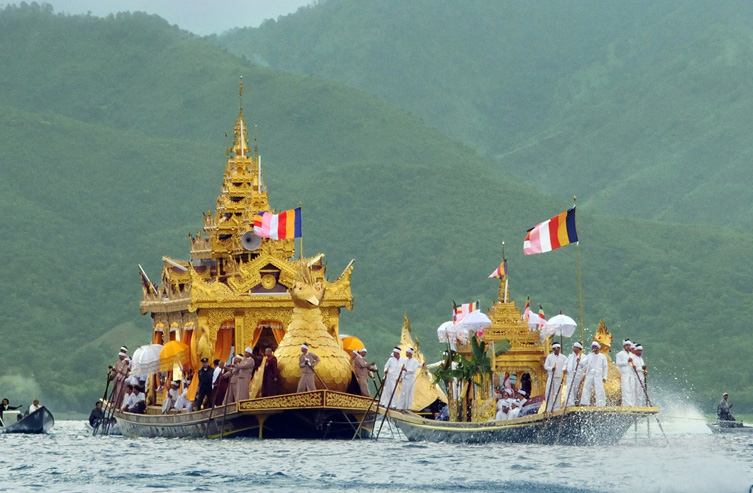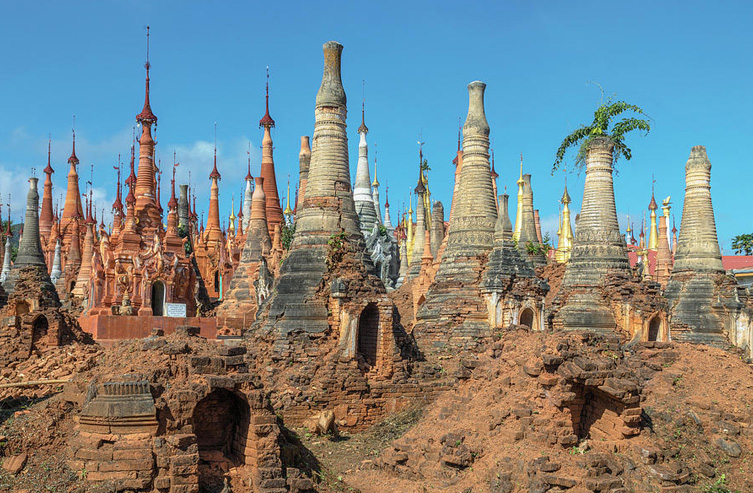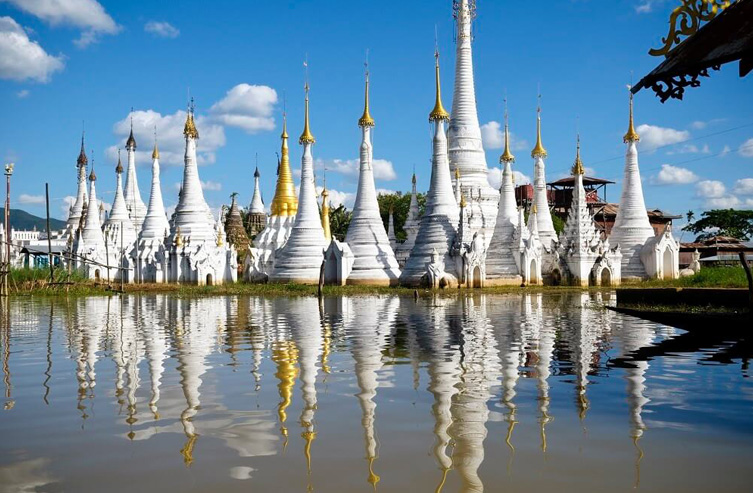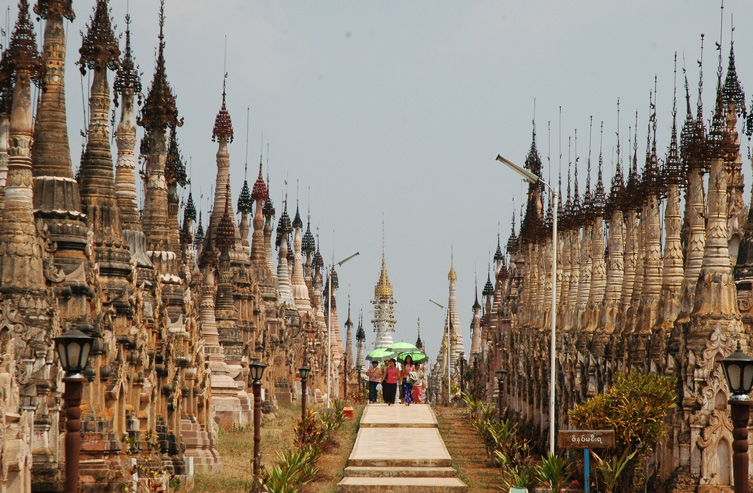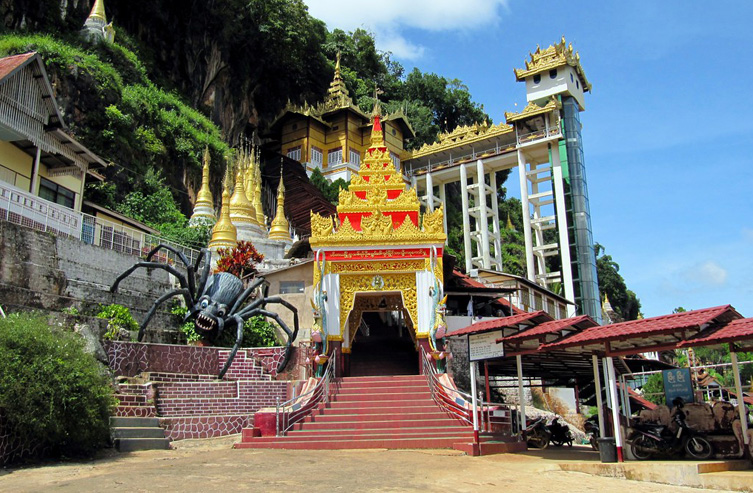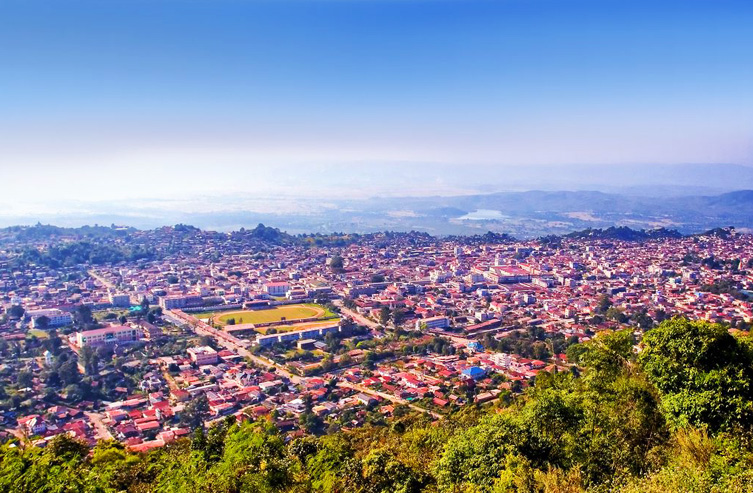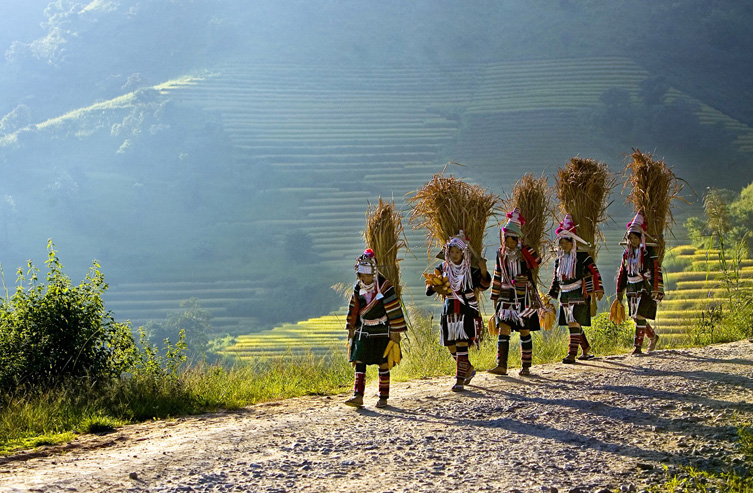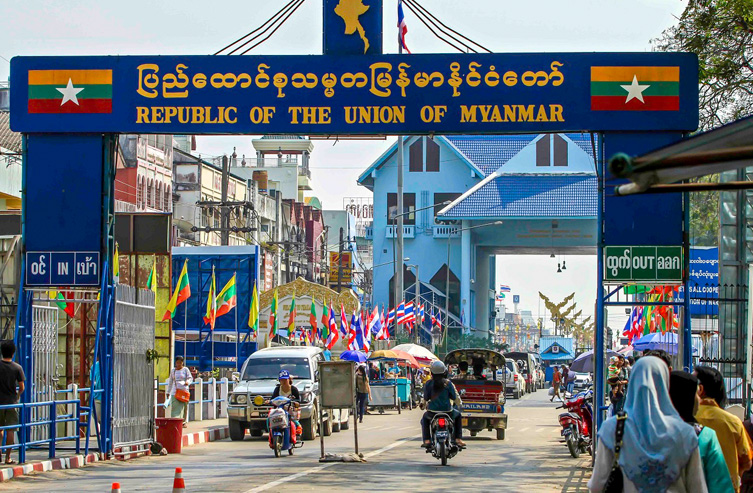In western Shan State, famous for its floating villages and gardens and the unique way of life of the local Intha people, with their living communities based entirely on the water. Inle Lake is the second largest natural lake in Myanmar. It is situated in the middle of the Nyaung Shwe Valley, nestled between two mountain ranges that extend north to south. The lake has a length of 22km and a width of 11km and is 875 metres above sea level. Inle Lake is 35 kilometres away from the nearest airport at Heho, and there are flights to there from both Yangon and Mandalay.
The lake is covered in local 17 villages and gardens which float on the limpid surface, and this is one of the most unique sights in the country, making it well worth the journey to get here. The lake does not actually have a shoreline; an individual cannot walk around it directly. The water of Inle Lake gets shallow as hyacinths and marsh paddies become dense; the path becomes impassable, and suddenly there is solid land.
The inhabitants of the island are called the Intha, and they devout Buddhists. This is the reason there are about a hundred Buddhist pagodas and about a thousand stupas in this area. The most remarkable feature of the lake is the leg-rowing Intha fishermen: they drive their flat-bottom boats by standing on the stern with one leg and using the other leg with the oar to row in order to obtain better vision over the reeds. The ideal time to visit Inle Lake is during the dry season, between October and May, November, in particular is very popular and hotels near the lake fill up quickly, so plan well in advance.
Inle Floating Village
The gorgeous Inle Lake in Myanmar is dotted with small floating villages made of wooden houses built on stilts. Over 80,000 people living on the lake are from the Intha Tribe but many other tribes from surrounding mountains head to the lake for the popular market days. If you take a boat ride on the Inle Lake, don't miss to see the floating market that moves between the floating villages on a five-day rotation.
The Ywama Village, located just south of Nga Phe Kyaung Monastery and northeast of the Indein Village, is part of the 5-day rotation of market. It is the most easily accessible village by boat from the town of Nyaung Shwe on the north side of the Inle Lake.
On the market day, the Ywama floating market is packed with tourist boats and souvenir vendors who do business with locals and tourists on the small boats that are loaded with handicrafts or produces. Only a few local farmers try to sell their vegetables to local buyers. On non-market days, there are only souvenir vendors and tourist boats, of course, the smart farmers are already at another market that rotates among the villages of Kaung Daing, Maing Thauk, Nam Pan, Indein and Thandaung. Just have a look at the five-day market schedule.
Phaung Daw Oo Pagoda
The Phaung Daw Oo Pagoda is located in Ywama and is an important religious site in the Shan State. it is also including in one of the most recognized shrines in Myanmar. The images are adorned with a thick layer of gold leaf as it is considered an act of worship for Buddhist devotees to stick a gold leaf foil to the images as they pass by. The name 'Phaungdawoo' means ‘front of the raft’ in Burmese. The five images are of different sizes, ranging from nine to eighteen inches tall. Being made of solid gold, the images are extremely heavy and are believed to be brought to Inle Lake by King Alaungsithu. The pagoda was built for the purpose of keeping these Buddha images.
Phaung Daw Oo Festival
The Phaung Daw Oo Pagoda plays host to one of the largest religious festivals in Myanmar, which takes place in the pagoda every year in September or October. The 18-day event includes a grand procession of Buddha images, a boat race and other activities. During the festival, Four of the five Buddha images in the Phaung Daw Oo Pagoda are transported on a royal barge which is pulled by big Inle traditional boats. The fifth image is left to guard others' resting places in the pagoda. Meanwhile, boat races are held near the pagoda. The rowers donning traditional costumes use their legs to paddle the boats, presenting a wonderful visual spectacle.
Nga Phe Kyaung (Jumping Cat Monastery)
The Nga Phe Kyaung is the biggest and oldest monastery in Inle Lake, Myanmar just north of Ywama. It is a beautiful wooden structure that was built on stilts over the lake at the end of the 1850s. The monastery is home to a collection of ancient Bagan, Shan, Tibet, and Inwa style Buddha images. The tall, mosaic-decorated pedestals and cases built for the images showcasing Shan and Northern Thai Buddhist art have a history of more than 100 years.
However, locally known as Jumping Cat Monastery, Nga Phe Kyaung Monastery is best known for the cats that were trained to jump through hoops. After the death of the head monk, the trained cats have all since died or retired, and the new head monk does not think it proper for monks to train cats to perform tricks for tourists. However, it is still possible to see some jumping cats.
Shwe Indein Pagoda
The Shwe Indein Pagoda is situated at the end of the marvelous Indein creek, which is linked to the Inle Lake after the Phaung Daw Oo Pagoda. The creek is narrow with many twists and turns. One can find a Buddha image enshrined in a whitewashed stupa found on the summit of a hill. Around the hill, there is a cluster of ancient stupas, most of which are ruins. It is said that the pagoda was built in the 17th and 18th century. At many places in the creek the farmers dam up the water by bamboo barriers to irrigate the paddy fields. Indein water is not only useful for irrigation also for bathing and washing clothes. It is compulsory to see Novice monks, buffalo boys and village girls wash and swim in the creek.
Sagar Village
A hidden village dramatized by the greenly scenery mountains amid the Shan Plateau near the Lake Inle is Sagar. A boat trip to the village of Sagar is beyond your imagination. The main attraction in Sagar is the sunken stupas, 108 old stupas from the 16-17th centuries that are partially underwater for a few months a year. Gazing at the blue hazy mountains, feeding groups of water birds that are chattering here and there on the Lake, scattering floating vegetations and happy-and-content Inthas (native to the Lake Inle) in their leg-rowing small boats… are some unique species appetizing those who are hungry for nature and cleanly environs.
Kakku Pagoda
Kakku is located 33 miles from Taunggyi, the capital of the Shan State, and is a 2.5-hour car journey from Inle Lake. One of Myanmar’s most spectacular sights, Kakku is a huge collection of 2,478 stupas which are believed to have been commissioned as far back as 2,00 years ago with some dating the site back to the 3rd Century BC and credit it as being founded by the Indian Emperor Ashoka. The original pagoda collection was extended by King Alaungsithu in the 12th Century when he reigned over Bagan and many more were added in the 17th and 18th Centuries.
Kakku is a site of religious devotion for Myanmar’s Pa’O people, the second largest ethnic group in the Shan State. The site has been restored extensively and, in recent years, has suffered destruction from extreme weather and earthquakes.
The Kakku Pagoda festival is held during Tabaung, the 12th month of the traditional Burmese calendar (March), which marks the end of the cool season. During the 9-day festival the Pa-Oh people dance in traditional costumes and bring food offerings and pay homage to the pagodas.
Pindaya
Pindaya Township is situated in the Taunggyi District in Shan State, which is 45km away from Kalaw. There’s a lot of beautiful landscape to be taken in when travelling from Kalaw to Pindaya. It is famous for its limestone caves, its attractive lakeside setting, and the traditional Shan paper umbrellas that are manufactured here.
The Pindaya Caves are a Buddhist pilgrimage site and a tourist attraction located on a limestone ridge in the Myelat region. These caves (some of which serve as meditation chambers) contain some 6000 Buddhas of various size, which are made of white marble, bronze, or plaster, and coated with gold leaf. At the entrance to the caves sits the 15-meter-tall Shwe U Min Pagoda. It’s said to have existed for the past 200 million years and is 5000 meters above sea level.
Before reaching the cave however visitors must pass through the Shwe U Min Pagoda, the entrance to which is guarded by a large spider statue. The massive bug is actually in reference to a local legend that gives the cave its name. the story goes that seven princesses were forced to take refuge in the cave but were sealed in by a giant spider’s web. They were eventually saved by a prince who killed the spider, and shouted, `Pinku Ya-Pyi!’ meaning, `I’ve got the spider!’ This would be truncated and elided over the centuries to ‘Pindaya’. Now every worshipper has a chance to see the spider for themselves.
A pagoda festival is celebrated at the base of Pindaya Hill which is lined with huge banyan trees. One of the villages of Danu is known as Hgnatpyawtaw and is a popular tourist destination.
At the base of Pindaya Hill is Singaung Monastery, a century old teakwood building which also has a lacquered-bamboo Buddha image. Ponetaloke Lake is another popular attraction at Pindaya.
Kalaw
Located in the Shan State, 50km from the famous Inle Lake, Kalaw was founded as a hill station by the British during colonial rule. At a height of 1,320 meters, the climate was a cool escape from the sweltering heat of the tropics, and it is also known as Myanmar’s trekking mecca.
Of the many houses built by the British in Kalaw around the turn of the century, a few still remain in various states of decay and disrepair. Most are now occupied by government or military officials, although some are still eerily silent, apparently undisturbed since their owners left 50 or more years ago.
Kalaw has a significant population of Nepali Gurkhas and Indian Hindus, Sikhs and Muslims who were brought to Kalaw by the British to build the railway line. Their influence is visible in the town with many local restaurants offering traditional Indian and Nepalese dishes with a Burmese twist.
Kalaw, places of interest are Nee Paya, Thein Taung Pagoda, Aung Chan Tha Pagoda, Su Taung Pyae Pagoda and the King Church. Other things to do Shop around for a trek. walk toward temples & churches. meet tribes at the colorful every-5-days market. take the stairs to a temple & a good view of the village. walk up the hill for an even better panorama. a pleasant 1.5 hours trip. taste strawberry lassi. feed birds. breathe fresh air filled with pine trees smell. while on trek. visit coffee. tea or cigar leaves plantations or see elephants at work.
Taunggyi
Taunggyi is situated in the southern Shan State and is the capital town of Shan States. It is 4.712 feet above the sea level and has a moderate climate. Also located about 500 kilometers north of Yangon and about 10 kilometers southeast of Mandalay. Taunggyi is situated on a high plateau surrounded by high mountains. The town was once a place for respite for perspiring British, although all that remains of the colonial era are on overgrown graveyard, a stone church, a line of cherry trees, etc. because of its function as a trade town from Thailand, China and India, this is one of Myanmar’s most prosperous and enterprising towns. The population of 200000 includes tribes, Shan, Myanmar, Sikhs, Punjabis and retired Gurakhas who once fought for the British. The bustling local market is interesting to observe the daily of the locals; the Shan state museum retells ho the state has passed the history and a famous pagoda with the panoramic view.
Loikaw
Loikaw is the capital of Kayah State & located in southern Shan Sate of Myanmar and on the Pilu River, a tributary of the Thanlwin River. Kayah State is packed with rolling hills, waterfalls, caves, and lakes - and as one of the least-populated states in Myanmar, it's the perfect place to get back to nature. Loikaw, in the north of the state near the Shan border, is the gateway to all this - and it's a wonderful destination in its own right, too.
When the British arrived in Myanmar, the area surrounding Loikaw was under the rule of a Saopha or "Sky Prince". During colonial times, there were 16 Saophas, each with autonomous rule over his own region. Shortly after independence, this tradition was brought to an end, and the Sky Princes lost their territory. Though he had no official power, the last Sky Prince of Loikaw lived until the 1990s, and his "palace" (now a monastery) can still be visited in the town today.
Loikaw's most impressive attraction, however, is not its Sky Palace but the Thiri-Mingalar Taung Kwe Pagoda Hill- a complex of buildings built on jagged outcrops of rock in the center of town. Though there's a lift to take you to the top of the pagoda, it's much more fun to ascend via the winding staircase at the front!
Loikaw is a wonderful base from which to explore the rest of Kayah State, with plenty of opportunities for trekking in the surrounding hills and villages. Most of the ethnic minorities in the state converted to Christianity in the 19th century, but you'll still find traditional practices thriving in rural communities - from Padaung ladies sporting their brass neck rings to clusters of totem poles used in shamanic divination.
Myanmar’s largest hydropower plant is located 20km east of Loikaw at Lawpita Water Falls and named as Lawpita Hydropower Plant. It is the main electric power source in Myanmar.
Kyaing Tong
Kyaing Tong is known for its scenic beauty and many colorful ethnic tribes. Situated in the eastern Shan State and 452 km from Taunggyi and 176 km from Tachileik. The name Kyaing Tong may be pronounced as Keng Tung, Chiang Tung, Cheingtung or Kengtong in accordance with origin influence including Thai and Chinese.
Kyaing Tong is a rewarding trekking destination. Places of interest around Kyaingtong are, the Spa, Naung Tong Lake, Sunn Taung Monastery, Central market and Traditional Lacquer ware works and weaving factory. There are many villages of various ethnic tribes resided around Kyaing Tong. Among the total 135 races of Myanmar, almost half of them lives in Shan state especially on the hills around the Kyaing Tong area. Within a day trek, you can reach the habitat of Loi, Akha, Lahu, Akhu, Palaung and Eng ethnic minorities.
There are regular flights from Yangon to Kyaing Tong. Visitors coming from Thailand are allowed to cross into this border town with border passes. Tachileik is also a border crossing point through which visitors from Thailand come to Myanmar. Regular air services are available between Heho, Mandalay, Tachileik and Yangon.
Tachileik
Located on the Myanmar - Thai border in the eastern Shan State, is a gateway to the heart of the Golden Triangle. The Friendship Bridge across the small Mae Sai stream links Tachileik with the northern Thai border town of Mae Sai. This is operating daily fly direct from Yangon to Tachileik in an hour. There is a ferry-landing site at Wanpon port on the Mekong River at the Myanmar - Laos border, 29 km from Tachileik. The road from Tachileik to Kyaing Tong is good and it takes only 3 hours by car to get there. The tourist can across border from Tachileik to Mae Sai with special permit.

 (+95-9) 7757 30372
(+95-9) 7757 30372



